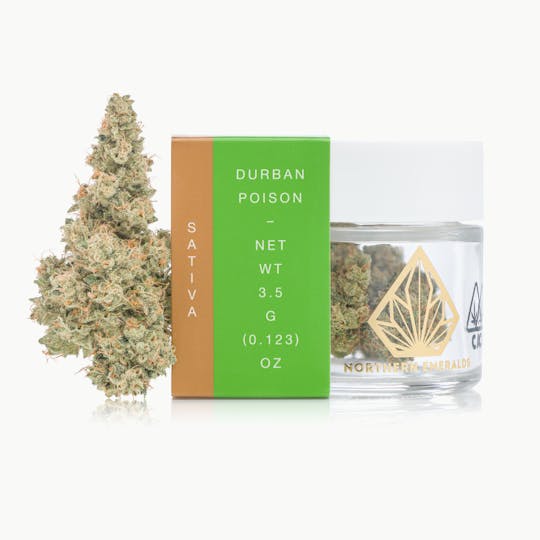
Durban Poison
DURBAN POISON
Durban Poison is one of the most desired sativas in the world. An original landrace sativa strain from South Africa, and a staple at most California dispensaries, Durban Poison is often referred to as the espresso of cannabis. This cultivar has an amazing aroma that fills up a room and is unmistakable. This unique terpene profile is dominated by Terpinolene which carries strong notes of sweet lemon and subtle pine.
Dominant Terpene: Terpinolene THC 32% - 40%
Terps - 3.5% - 4.5%
Sativa : Original landrace from South Africa
- Earthy
- Woody
- Spicy/Herbal
Northern Emeralds bring passion and professionalism to the cannabis industry with their top shelf flower. They believe that when dealing with a live plant, you get what you put into it, and Northern Emeralds puts a lot into their cannabis. Connoisseurs have come to appreciate their cultivation methods that make for flavorful and consistent quality flowers that provide medical and recreational benefits with every smoke. Northern Emerald’s love cannabis and takes pride in trying to show the beauty of the plant while elevating every aspect of their cannabusiness.
History:
Although established in 2015, the cultivators at Northern Emeralds have been growing for many years. Starting with their passion for cannabis and for their endless curiosity towards the science of cultivating, the growers started developing, tweaking and refining their methods in search of the perfect process. When they started as a small business, they won over dispensaries not only with their high-quality flower but with their professionalism and proficiency. Their promptness and attention to detail made them easy and desirable to work with, in addition to providing consistent products each and every week. Growing from just a few employees to over fifty, Northern Emeralds is one of the biggest cannabis companies in all of Humboldt. They made a name for themselves in San Francisco, Sacramento, San Jose, and Los Angeles, and are becoming one of the most recognized brands throughout all of California. Northern Emerald’s strives to be a professional and polished brand that earns the respect of those in the marijuana industry and community, from dispensary owners, extract artists and consumers alike.
Process:
Northern Emerald’s doesn’t play the strain game; it’s all about method. Through the perfecting of their cultivation process, Northern Emerald manages to get the very best out of the cannabis plant. They meticulously trim their flowers to ensure they look beautiful, with sparkling trichomes that highlight the beauty of the flower. Working in small batches to provide top shelf cannabis that provides smooth, clean smoking experiences, Northern Emeralds can adapt their growing methods depending on the particular need of each strain. Every strain needs something different, and they work with fewer plants to give the full attention each plant needs.
Products:
Northern Emerald’s was put on the map thanks to their two signature strains: Titan OG and Sapphire Kush. With everything you could ever want out of a classic OG and Kush flower, these two possess distinct flavor, aroma, and effects.
Lab Testing:
Northern Emeralds is fully compliant with all state and local regulations, and they test their flower with CW Analytical. They test for everything from cannabinoid potency, pesticides, microbial, and contaminants.
www.NorthernEmeralds.com
Durban Poison has deep roots in the Sativa landrace gene pool. The strain’s historic phenotypes were first noticed in the late 1970s by one of America’s first International strain hunters, Ed Rosenthal. According to cultivation legend, Rosenthal was in South Africa in search of new genetics and ran across a fast flowering strain in the port city of Durban. After arriving home in the U.S., Rosenthal conducted his own selective breeding process on his recently imported seeds, then begin sharing. Rosenthal gave Mel Frank some of his new South African seeds, and the rest was cannabis history.
Frank, who wrote the “Marijuana Grower’s Guide Deluxe" in 1978, modified the gene pool to increase resin content and decrease the flowering time. In search of a short-season varietal that could hit full maturation on the U.S. East Coast, Frank’s crossbreeding efforts resulted in two distinct phenotypes, the “A” line and “B” line. The plant from Frank’s “A” line became today’s Durban Poison, while the “B” line was handed off to Amsterdam breeder David Watson, also known as “Sam the Skunkman.”
Durban Poison has a dense, compact bud structure that’s typical of landrace Indica varieties, but the flowers’ elongated and conical shape is more characteristic of a Sativa.